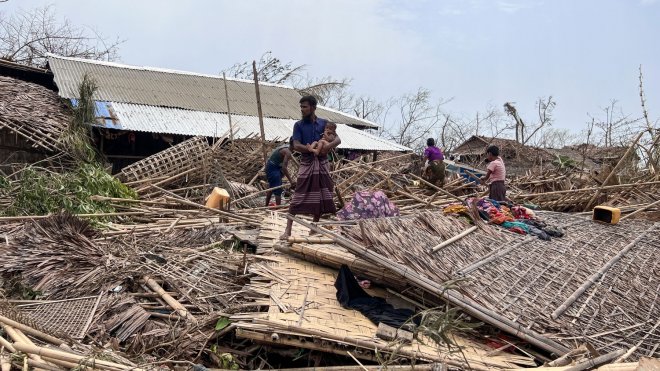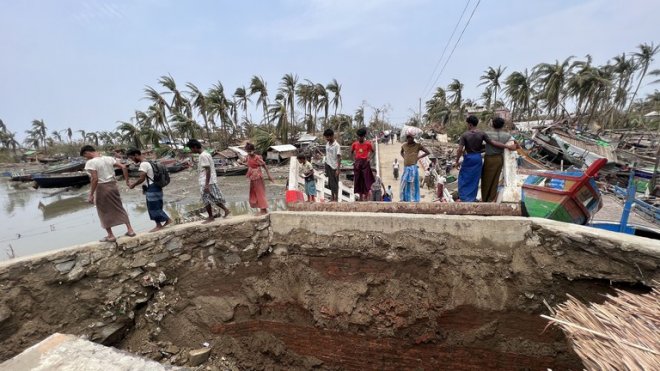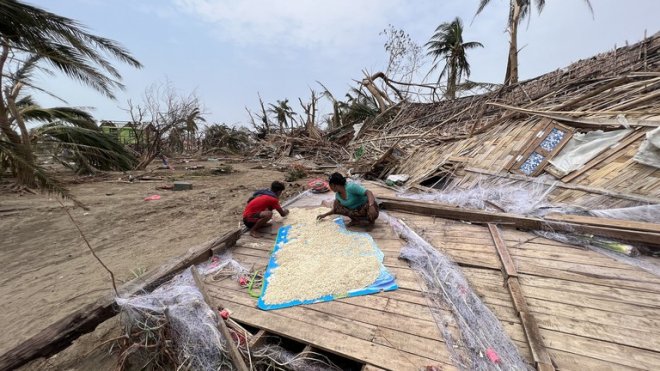
Cyclone Mocha killed about 460 Rohingya villagers in Myanmar’s Rakhine – deaths that humanitarian workers said could have been prevented if so many people hadn’t been living in restricted camps near the seashore.
Most villagers weren’t properly informed of the coming storm, which hit the coast on Sunday with sustained winds reaching over 220 kilometers per hour (137 mph), and many others weren’t allowed to evacuate ahead of time, activists and aid workers told Radio Free Asia.
The number of dead “could increase significantly as many people are missing,” the UK-based Burmese Rohingya Organization, or BROUK, said in a statement on Wednesday.
Communication services are down in large parts of Rakhine, in western Myanmar, and no humanitarian aid has reached affected areas in and around the state capital of Sittwe, the group said.
“All shelters have been destroyed in the camps, and people have witnessed many family members being carried away by flash floods caused by the cyclone,” it said.
Other people in the area were killed by wind-blown tree branches and zinc roof sheets.
Some 130,000 Rohingya have lived for more than a decade in internally displaced persons camps in the Sittwe area. BROUK likened the camps “to open air prisons.”
A Rohingya survivor from Thet Kae Pyin camp said bodies belonging to 110 Rohingya villagers were buried on Monday and Tuesday.
Another survivor, a 25-year-old, told RFA that the Rakhine State military council had warned them of the storm several days before it struck. However, all emergency shelter centers were already overcrowded with people.
“The government and NGOs warned us in advance, but there wasn’t enough space for us to evacuate. That’s why we just continued staying in our camp,” the 25-year-old said, asking not to be identified for security reasons.
“As our camp is in close proximity to the sea, the children and elderly were washed away and died in the flood during the cyclone.”
 People pick their way through debris and a destroyed bridge near the Dar Paing Rohingya camp in western Sittwe, Myanmar, Wednesday, May 17, 2023. Credit: RFA
People pick their way through debris and a destroyed bridge near the Dar Paing Rohingya camp in western Sittwe, Myanmar, Wednesday, May 17, 2023. Credit: RFA
Sudden rise in sea level
During the storm, the sea level suddenly rose nearly 10 meters (30 feet) and almost all the huts in one camp were washed away, said Nay San Lwin, co-founder of the Free Rohingya Coalition.
There are nearly 380 houses in the Bay Dar camp, located on an island on the coast of the Bay of Bengal. But after the storm, only six remained and hundreds of people were missing, he said.
RFA is still working to determine the exact number of Rohingya deaths in Rakhine.
Two Rohingya villagers contacted by RFA said that it has been difficult to collect every dead body that was washed into the sea.
Maung Sein, a Bay Dar resident, told RFA that his 5-month-pregnant wife, his son, his mother-in-law and brother-in-law were killed by the storm, and his son’s body was missing. He said he was with his family when the storm hit, and survived because he knew how to swim.
“I have never seen waves that big in my entire life,” he said. “A gigantic wave washed away my family.”
 People dry salvaged grain in the Dar Paing Rohingya camp in western Sittwe, Myanmar, Wednesday, May 17, 2023. Credit: RFA
People dry salvaged grain in the Dar Paing Rohingya camp in western Sittwe, Myanmar, Wednesday, May 17, 2023. Credit: RFA
No ‘effective help yet’
Newspapers published on Tuesday reported that junta chief Senior Gen. Min Aung Hlaing visited Sittwe on Monday and gave 70 billion Kyat (US$24.5 million) worth of supplies.
But a Rohingya resident in Sittwe told RFA that he hasn’t received any aid.
“I haven’t seen any effective help yet. Nor have I heard of any,” he said. “Those whose houses were completely destroyed were found to be living on the side of the road under tarpaulins. They are in desperate need of food and shelters.”
In a flash update on Wednesday, the United Nations Office for the Coordination of Humanitarian Assistance said that “widescale destruction of homes and public infrastructure” was seen throughout Rakhine.
“Urgent needs include shelter, clean water, food assistance and health care services,” UNOCHA said. “There are rising concerns in flooded areas about the spread of waterborne disease and the movement of landmines.”
RFA called the junta spokesman for Rakhine state, Hla Thein, on Wednesday but his phone rang unanswered.
Conditions in other Rohingya villages and camps in Rakhine – in Ponnagyun, Buthidaung and Maungdaw townships – were still unknown. RFA tried to contact six Rohingya residents of Buthidaung and Maungdaw townships on Wednesday, but their telephone connections were out of service.
Translated by Myo Min Aung. Edited by Matt Reed and Malcolm Foster.